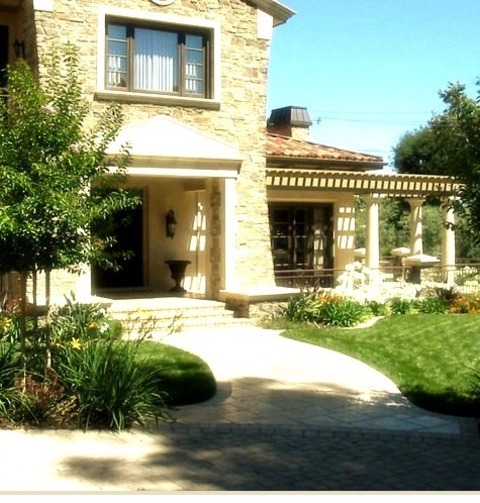#landscape plan
Explore tagged Tumblr posts
Text
Boise Brick Pavers Front Yard

Photo of a large mediterranean full sun front yard brick landscaping in spring.
1 note
·
View note
Text
Natural Stone Pavers Milwaukee

A photograph of a medium-sized, modern front yard with a wood fence and some partial sun.
0 notes
Photo

Patio in Milwaukee Patio - mid-sized modern backyard concrete patio idea with a pergola
0 notes
Photo

Natural Stone Pavers - Front Yard Photo of a large transitional full sun front yard stone flower bed in summer.
0 notes
Photo

Transitional Landscape in Milwaukee Design ideas for a large transitional full sun front yard stone flower bed in summer.
0 notes
Photo

Modern Patio - Concrete Slab Inspiration for a mid-sized modern backyard concrete patio remodel with a pergola
0 notes
Text
"Amsterdam’s roofs have just been converted into a giant sponge that will make the city more climate resilient.
The Dutch have always been famous for their ability to control water, born out of the necessity of their homeland, much of which is below sea level.
Now, their expert water management skills are transforming the city skyline in the capital city of Amsterdam from one of terracotta tile, concrete, and shingles into green grass and brown earth.
It’s part of a new climate-resiliency trend in architecture and civic planning known as the ‘sponge city concept,’ in which a garden of water-loving plants, mosses, and soil absorbs excess rainwater before feeding it into the building for use in flushing toilets or watering plants on the ground.
If heavy rains are predicted, a smart valve system empties the stored rainwater into the municipal storm drains and sewers in advance of the weather, allowing the roof to soak up water and reduce flooding in the city.
In this way, the rooftops of buildings can be wrung out and filled up just like a sponge.
In Amsterdam, 45,000 square meters, or 11 acres of flat metropolitan rooftops have already been fitted with these systems, and the contracting firms behind the technology say they make sense in dry climates like Spain just as much as in wet climates like Amsterdam...
A 4-year project of different firms and organizations called Resilio, the resilient network for smart climate adaptive rooftops, rolled out thousands of square meters of sponge city technology into new buildings. As with many climate technologies, the costs are high upfront but tend to result in savings from several expenditures like water utilities and water damage, over a long-enough time horizon...
All together, Amsterdam’s sponge capacity is over 120,000 gallons.
“We think the concept is applicable to many urban areas around the world,” Kasper Spaan from Waternet, Amsterdam’s public water management organization, told Wired Magazine. “In the south of Europe–Italy and Spain–where there are really drought-stressed areas, there’s new attention for rainwater catchment.”
Indeed the sponge city concept comes into a different shade when installed in drought-prone regions. Waters absorbed by rooftops during heavy rains can be used for municipal purposes to reduce pressure on underground aquifers or rivers, or be sweated out under the Sun’s rays which cools the interior of the building naturally.
Additionally, if solar panels were added on top of the rooftop garden, the evaporation would keep the panels cooler, which has been shown in other projects to improve their energy generation.
“Our philosophy in the end is not that on every roof, everything is possible,” says Spaan, “but that on every roof, something is possible.”
Matt Simon, reporting on the Resilio project for Wired, said succinctly that perhaps science fiction authors have missed the mark when it came to envisioning the city of the future, and that rather than being a glittering metropolis of glass, metal, and marble as smooth as a pannacotta, it will look an awful lot more like an enormous sculpture garden."
-via Good News Network, May 15, 2024
#amsterdam#netherlands#green roof#blue roof#city planning#urban#urban landscape#flood#climate change#climate action#climate emergency#climate hope#solarpunk#hope posting#go green#eco friendly#climate adaptation#sponge city#urban planning#good news#hope#rooftop garden
2K notes
·
View notes
Photo

Milwaukee Pergola Patio medium-sized minimalist backyard patio image showing a pergola
0 notes
Text

ribbonwood
#linked universe#linkeduniverse#lu hyrule#(also zelda 1!!! but idk how people would feel about me tagging it since I used Jojo's design?)#(ya'll can always tag my gen loz art as LU (or as any linkverse honestly if it inspires you to think about your favs) and vice versa)#(I want to inspire you to think and create! If you see my gen loz art and want to add that to your headcanons or it changes how you think??#take it! play with it! invite me to play as well haha!)#(not ocs but like- gen stuff??? ye go for it)#mom walked in and looked at the comic I was working on#so I started rambling about my plans with it and what my peers are working on and how cool it all is and how I want to have more of that#and she said “what a waste of time”#so I got loosey goosey with it :\#nice exercise to just draw w/o doing guides or being careful#did this in like under 15 minutes! >:D#but anyways#I haven't slept yet so gn!#.. he's holding stuff in the wrong hands!!!! a#look up ribbonwood / redshanks trees! If Hyrule was a tree- this is it#I imagine zelda 1&2's landscape to be california chaparral!!! I'm really passionate about it!!!!!#check out the california chaparral institute's website -> chaparral -> chaparral types#it's Hyrule's Hyrule!
785 notes
·
View notes
Text

The Rain Master 🌧️🌾


Some close ups of the rain and sword glitter
9 x 12" watercolor, white and metallic inks, salt
#watercolor#tgcf#tian guan ci fu#heavens official blessing#rain master#yushi huang#landscape#traditional art#artists on tumblr#shes just so cool#ive got another painting planned for her but idk#one that was involves combat
208 notes
·
View notes
Text

sunrise in the snow
#new mexico#landscape photography#nature photography#film photography#35mm#filmisnotdead#mountains#plans#mullein#winter#snow#sunrise#pastel#naturecore#lensblr#photographers on tumblr#original photographers#diary
80 notes
·
View notes
Text


Growing!
#photography#nature#forest walk#forest#nature lovers#summer vibes#nature colors#nature beauty#good vibes#small plants#quiet place#vibes#summer vibin'#summer photography#summer plans#sun day#sunny#water drops#water#river#nature blog#beautiful#unbelievable#fyp tumblr#forest vibes#nature vibes#nature view#nature landscape#forest landscape#landscape
94 notes
·
View notes
Text

Jan van der Groen, Den Nederlandtsen Hovenier (The Netherlandish Gardener), Designs for Flower Beds, 1659-1671
#Jan van der Groen#art#design#garden#landscape#landscape architecture#diagram#designs for flower beds#Den Nederlandtsen Hovenier#The Netherlandish Gardener#square#organization#plan
106 notes
·
View notes
Text

Sibiu, Romania visit.sibiu
#Sibiu#Romania#visit.sibiu#europe#europe_gallery#transylvania#europe_vacations#europe_pics#europe_greatshots#europe_perfection#europe_photogroup#nature photography#flowers#architecture#old town#travelling#travel#travel photography#urban photography#urban#urban planning#urban landscape#urban life#cityscape#urban fantasy#streets#city#street photography#travel destinations#beautiful destinations
189 notes
·
View notes
Text







Hero & Partner Week (@heropartnerweek) - Day 6: Farewell | Alone | Return
"No matter how great the distance between us... Wherever you are... Whenever it is... ...I won't ever forget you."
#pokemon#art#pkmn#pkmnart#pokemon mystery dungeon#pmd#pmd gti#pmd gates to infinity#axew#oshawott#pokemon oc#pmd ocs#i'm LATE#AGAIN#SORRY#i cannot do detailed backgrounds man#landscapes AND interior housing?? i am sobbing hndgdsfhn#I've had this planned since day one tho hehehe#gates to infinity. i love this game.#hero & partner week#heropartnerweek#long post#(oc) axdrew#(oc) brooke
712 notes
·
View notes
Text


Sleepy in the woods🌿
#something about the 5am and forest islands… i might have to set the da for this island a bit earlier than i had planned!??#toadstool island#acnh#animal crossing#animal crossing new horizons#new horizons#acnh island#acnh exterior#acnh spring#acnh forestcore#acnh forest#acnh river#acnh landscaping#acnh inspiration#acnh inspo#acnh cozy#acnh morning#acnh 5AM
158 notes
·
View notes